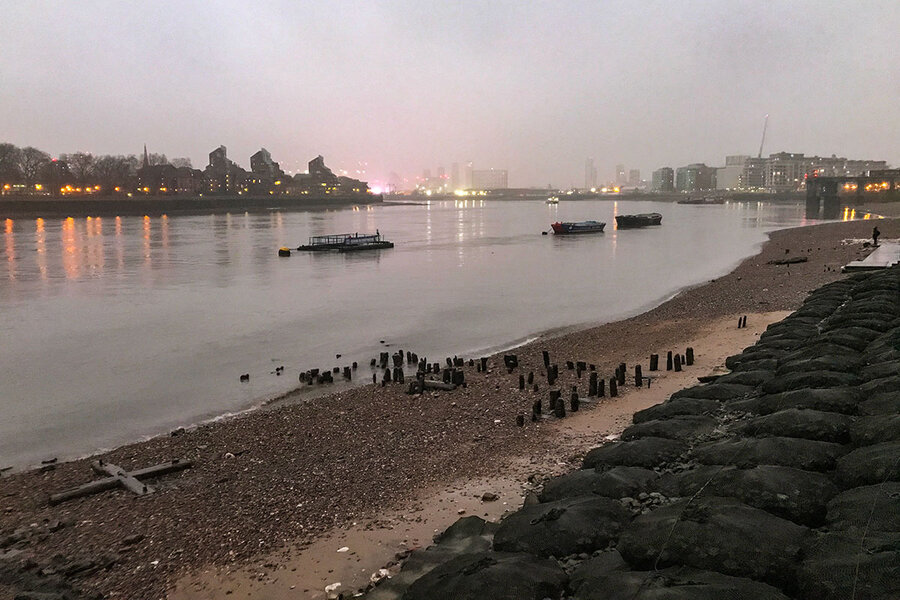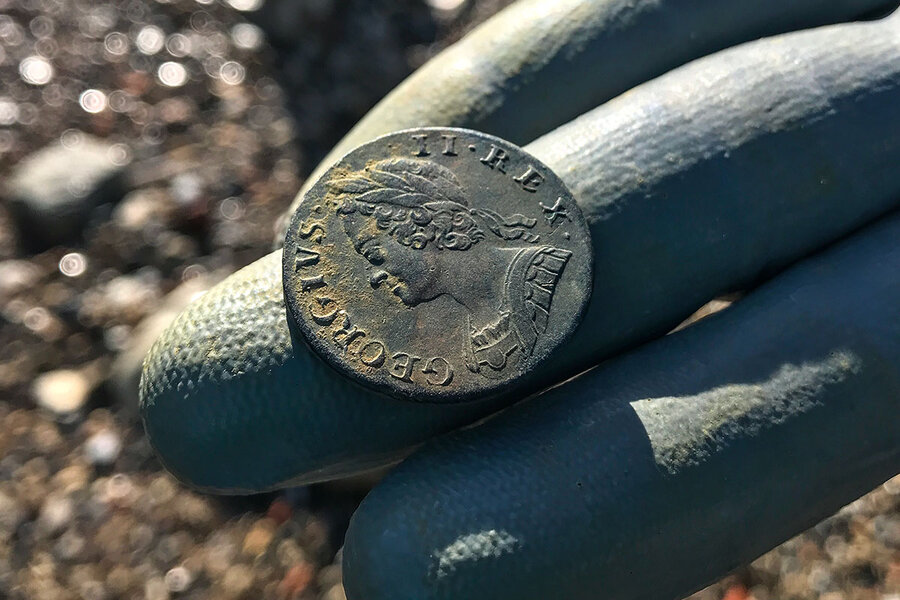‘Mudlarks’ dig up London’s past on the banks of the River Thames
Loading...
| London
Britain’s rivers, particularly the River Thames, have long been the site of “mudlarking,” an 18th-century scavenging profession turned modern pastime that involves looking for ownerless objects that have been lost, discarded, or displaced. Amid the pandemic, mudlarking has become an escape from the monotony of lockdowns and the peril of crowds – as well as a window onto the past and a break from urban life.
The Port of London Authority, which issues mudlarking permits for people to hunt for archaeological objects along the Thames foreshore, has seen numbers increase significantly during the pandemic. Last year the PLA issued 1,363 permits, up from an even 1,000 in 2019 and double the number issued in 2018.
Why We Wrote This
For some Londoners, poking around the shores of the River Thames for lost artifacts, aka mudlarking, isn’t just a pastime. It’s a way to escape the hustle of urban life and relieve the tensions of the pandemic.
Lara Maiklem has amassed a global following as a mudlark, with some 175,000 followers across social media keeping track of her latest finds on the shores of the Thames. Silver rings, Roman coins, and fragments of pottery dating back to the Iron Age are among some of the common items found. They are usually fragments thrown away by Londoners of the past, she says.
“I kept going back to the river and every time I seemed to find something different,” says Ms. Maiklem. “It just became my go-to place to escape.”
It was almost 20 years ago when, waiting for a delayed friend, Lara Maiklem found herself by the River Thames at low tide. Stepping off a set of creaky wooden steps onto the muddy shore, she found the discarded, disused stem of a clay pipe.
Little did she know that her moment of curiosity would spark into an obsession for “mudlarking,” an 18th-century scavenging profession turned modern pastime that involves looking for ownerless objects that have been lost, discarded, or displaced, often by a beach or by the side of a river.
While Ms. Maiklem was unable to find in London’s parks the solitude she had enjoyed on the farm of her youth, she found it in London’s river. In that “ribbon of tranquility cutting through the city,” she says, she would regularly look for a treasure-trove of objects retelling the history of London. In doing so, she quenched her thirst for peace.
Why We Wrote This
For some Londoners, poking around the shores of the River Thames for lost artifacts, aka mudlarking, isn’t just a pastime. It’s a way to escape the hustle of urban life and relieve the tensions of the pandemic.
“I kept going back to the river and every time I seemed to find something different,” says Ms. Maiklem. “It’s thoroughly addictive because it’s like a great lucky dip, you just don’t know what you’re going to find next or what the tide will wash up. It just became my go-to place to escape.”
And during the pandemic, mudlarking has become that much more important for Londoners looking to escape the monotony of lockdowns and the peril of crowds. It provides a window on the past and a break from urban life.
“Ten feet above you at street level, it’s manic. But by the riverbank, there are only five or six people at most,” says Joe Allen, a mudlark for five years. “There’s a sense of being back in time, in the old London before new housing developments existed.”
Flocking to mudlarking
When Prime Minister Boris Johnson announced Britain’s first COVID-19 lockdown in March 2020, he inadvertently brought London’s famous river to an abrupt standstill. The River Thames was as quiet “as it’s ever been in 2,000 years, left to itself, returning to nature so quickly because there were no boats,” says Ms. Maiklem, author of “Mudlarking: Lost and Found on The River Thames.” The lack of river traffic, though, meant that silt simply settled, leaving the shore harder to explore for local mudlarks wishing to take their permitted daily walk in lockdown.
As restrictions eased, mudlarking as a pastime – already popular before the pandemic – boomed. The Port of London Authority, which issues mudlarking permits allowing people to hunt for archaeological objects along the Thames foreshore, issued 1,363 such permits last year, up from 1,000 in 2019 and double the number issued in 2018.
By law, mudlarks must report finds that are 300 years old or more, and anything of archaeological importance, to the Portable Antiquities Scheme run by the British Museum. “It’s really important to record what people find because it’s part of our collective history,” says Ms. Maiklem. She urges mudlark newcomers to act like custodians and to “keep a story alive” by sharing objects with other people.
Indeed, she has amassed a global following doing just that, with some 175,000 followers across social media keeping track of her latest finds in the muddy, windy mouth of the River Thames. Silver rings, Roman coins, and fragments of pottery dating back to the Iron Age are among some of the commonly found items. They are usually fragments thrown away by Londoners of the past, the equivalent of modern garbage, she says.
More unusual items include an impression of a dog paw in a medieval tile, “frozen in time.” More recently, she discovered a rare 15th-century pilgrim badge originally from a shrine dedicated to the Virgin Mary – the equivalent of a modern tourist souvenir. “It’s thought that when they got back to London, they would ritually bend them in half. People have been making offerings to the River Thames forever,” says Ms. Maiklem.
The Thames has a long history of churning up religious artifacts. It has been a sacred river ever since the first hunter-gatherers offered precious stone tools to the spirits they believed dwelled within it. Today, people throw all manner of modern religious objects, such as Islamic and Jewish amulets, into the Thames. By far the most common sacred objects found by mudlarks are from Hindu rituals. Indian oil lamps, called diya, are often found in autumn around Diwali, the Festival of Lights.
“Solitude and ‘me time’”
Michal Knap started browsing the shores of the Thames in June 2020, three months into Britain’s first lockdown. Business and the frenetic pace of work life pre-COVID-19 had left him no time for it. When life came to a standstill, Mr. Knap took the opportunity to fulfill his ambition of “pretending to be an archaeologist.”
He says it also provides a source of community and belonging, particularly as he is deaf. “But mudlark communication can be difficult, too ... because the tide always turns quickly and many people don’t have the time to speak slowly or write in that environment.”
Mudlark Mr. Allen runs an online community where mudlarks share photos of their finds. He has noticed a growth in online mudlarking forums and groups since the pandemic started. His own Thames Mudlarking group has attracted “a few thousand members” including many abroad, especially in the Netherlands and United States, he says. He works in the heart of London on a daily basis and says mudlarking offers “a different perspective” from the frenetic pace of city life.
For Ms. Maiklem, mudlarking offered the chance for “solitude and ‘me time’” after giving birth to her children, a time “where no one has any demands.”
The increased interest in mudlarking has brought some problems, worries Jane Parker, who says she makes necklaces from objects found by the river only after “thoroughly checking to see if it’s allowed” to keep her discoveries. She fears that newcomers are attempting to mudlark without the right permits from local authorities.
“It’s like going into a front garden, taking someone’s garbage and saying, ‘Look what I found,’ without permission,” says Ms. Parker.
Nonetheless, serial mudlarks like Ms. Maiklem say they believe their pastime can give a sense of hope in “very uncertain times.”
“A lot of people are looking for a connection, an explanation, or some hope for the future. I get a great deal of comfort from looking back because it makes you realize that we haven’t changed,” she says. “We might be wearing different clothes and speaking a little bit differently, but we’ve all got the same hopes and fears. People fall in love, they have their hearts broken.”
“We’ve been through worse. The human condition doesn’t change,” she adds. “The evidence that we will get through this is hidden in the mud.”










